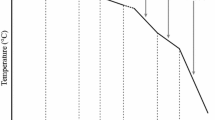Abstract
The Gibbs method permits simultaneous evaluation of the relationships among all intensive thermodynamic variables of a heterogeneous system in equilibrium. Addition of mass balance constraints permits simultaneous evaluation of both intensive and extensive variables so that changes in phase chemistry and modes may be monitored. Assumption of closed system behavior results in a system of equations with two degrees of freedom, regardless of the thermodynamic variance, as specified by Duhem's theorem. Open system behavior increases the number of degrees of freedom by the number of components to which the system is open. The methodology presented is therefore a formal statement of the constraints among the differential of all of the intensive and extensive variables of a heterogeneous system.
Examples of the application of this formalism include contouring pressure-temperature space for mineral composition, modal changes and reaction progress; contouring reaction space with pressure, temperature and mineral composition; and calculation of compositional and modal changes of phases for prescribed changes in pressure and temperature, as, for example, in the calculation of synthetic garnet zoning profiles or liquid lines of descent in crystallizing magmas.
Similar content being viewed by others
References
Berman RG, Engi M, Greenwood HJ, Brown TH (1986) Derivation of internally-consistent thermodynamic data by the technique of mathematical programming: a review with application to the system MgO-SiO2-H2O. J Petrol 27:1143–1364
Bohlen SR, Boettcher AL (1981) Experimental investigations and geological applications of orthopyroxene geobarometry. Am Mineral 66:951–964
Brown TH, Skinner BJ (1974) Theoretical prediction of equilibrium phase assemblages in multicomponent systems. Am J Sci 274:961–986
Ferry JM (1983) On the control of temperature, fluid composition, and reaction progress during metamorphism. Am J Sci 283-A:201–232
Ghiorso MS (1985) Chemical mass transfer in magmatic processes. I. Thermodynamic relations and numerical algorithms. Contrib Mineral Petrol 90:107–120
Helgeson HC, Delany JM, Nesbitt HW, Bird DK (1978) Summary and critique of the thermodynamic properties of rock-forming minerals. Am J Sci 278A:1–299
Hodges KV, Spear FS (1982) Geothermometry, geobarometry and the Al2SiO2 triple point at Mt. Moosilauke, New Hampshire. Am Mineral 67:1118–1134
Kimball KL, Spear FS, Dick HJB (1983) High temperature alteration of abyssal ultramafics from the Islas Orcadas Fracture Zone, South Atlantic. Contrib Mineral Petrol 91:307–320
Prigogine I, Defay R (1954) Chemical Thermodynamics. Longmans, Green and Co., London
Rice JM, Ferry JM (1982) Buffering, infiltration and the control of intensive variables during metamorphism. In: Ferry JM (ed) Characterization of Metamorphism through Mineral Equilibria. Mineral Soc Am [Reviews in Mineral] 10:263–326
Russell JK, Nicholls J (1985) Application of Duhem's theorem to the estimation of extensive and intensive properties of basaltic magmas. Can Mineral 23:479–488
Spear FS, Cheney JT (1986) Yet another petrogenetic grid for pelitic schists. Geol Soc Am Abstracts with Programs 18:758
Spear FS, Ferry JM, Rumble D (1982) Analytical formulation of phase equilibria: The Gibbs method. In: Ferry JM (ed) Characterization of Metamorphism through Mineral Equilibria. Mineral Soc Am [Reviews in Mineral] 10:105–152
Spear FS, Selverstone J (1983) Quantitative P-T paths from zoned minerals: Theory and tectonic applications. Contrib Mineral Petrol 83:348–357
Thompson JB (1982) Reaction space: an algebraic and geometric approach. In: Ferry JM (ed) Characterization of Metamorphism through Mineral Equilibria. Mineral Soc Am [Reviews in Mineral] 10:33–51
Thompson JB, Laird J, Thompson AB (1982) Reactions in amphibolite, greenschist and blueschist. J Petrol 23:1–17
Author information
Authors and Affiliations
Rights and permissions
About this article
Cite this article
Spear, F.S. The Gibbs method and Duhem's theorem: The quantitative relationships among P, T, chemical potential, phase composition and reaction progress in igneous and metamorphic systems. Contr. Mineral. and Petrol. 99, 249–256 (1988). https://doi.org/10.1007/BF00371465
Received:
Accepted:
Issue Date:
DOI: https://doi.org/10.1007/BF00371465




